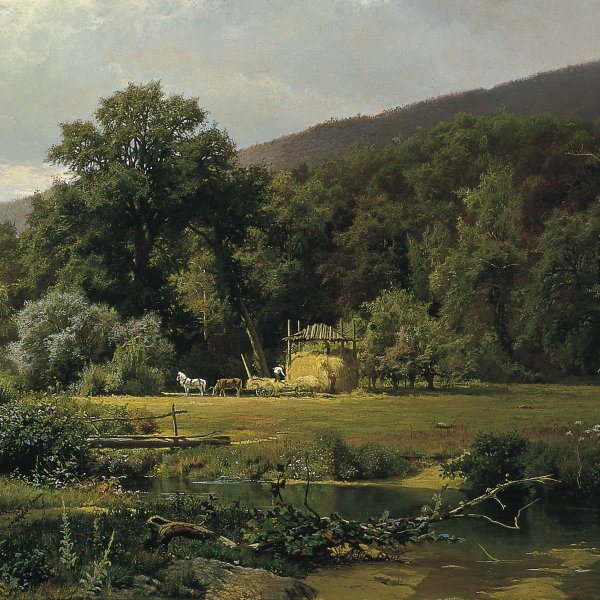Hugh Bolton Jones
Baltimore, 1848-Nueva York, 1927
Hugh Bolton Jones, the son of a well respected Baltimore family, was born on 20 October 1848. As a youth he attended drawing classes at the Maryland Institute, studying under David Acheson Woodward. In 1865 Jones studied in New York with Carey Smith and for a few months with Horace W. Robbins, before Robbins travelled with Frederic E. Church to Jamaica. While in New York, Jones became good friends with the painter, Thomas Hovenden. By 1867 he had begun to exhibit at the National Academy of Design. After he had completed his studies, Jones returned to Baltimore and set up a studio with Hovenden in 1868. He went on a four-month tour of Europe with his family during the summer of 1870, and in 1871 he exhibited English and Irish scenes at the Baltimore Artists' Sale, as well as a painting entitled The Wheat Harvest. By 1872 he was a member of the Allston Association, an organisation of Baltimore artists and collectors. During the summer of 1873, Jones travelled by rail on sketching excursions through Maryland and Virginia. The following April his painting, Summer in the Blue Ridge, which was exhibited at the National Academy of Design, attracted much attention.
H. Bolton Jones travelled with his younger brother, Francis Coates Jones to Paris in 1876 where he may have studied at the Académie Julian. By 1877 the two brothers joined Thomas Hovenden at the artists' colony of Pont-Aven, Brittany where they were associated with Robert Wylie, who died suddenly that year, and William L. Picknell, who often painted side by side with H. Bolton Jones. The brothers travelled to Spain and North Africa as well as to Switzerland, Italy, and Belgium. While in Europe, Jones exhibited at the Paris Salon, the Paris Exposition of 1878, and at the Royal Academy, London.
Jones returned to New York in 1881 and that year was elected an associate of the National Academy of Design; two years later he became an academician. He was elected a member of the Society of American Artists in 1881, a member of the American Water Color Society in 1882, and participated in the first exhibition of the Society of Painters in Pastels in 1884. From 1883-1889 Jones painted at Annisquam, Massachusetts, where William l. Picknell and others recreated their artistic colony from Pont-Aven. Jones was praised for his subtle and harmonious depictions of nature in a Barbizon style but was criticised for adhering to the careful description of nature which characterised the Hudson River School painters. Around 1890 he made a trip west to gather material for Charles Dudley Warner's Our Italy, a book on western America published in 1891.
Jones lived in New York but spent summers in South Egremont, Massachusetts, painting and sketching in the Berkshires. He was a member of the National Institute of Arts and Letters, Century Association, and Charcoal Club. He received medals at the World's Colombian Exposition in Chicago in 1893, the Louisiana Purchase Exposition in St. Louis in 1904, and the Panama-Pacific Exposition in San Francisco in 1915. From its foundation in 1914 until his death, Jones was trustee of the Baltimore Museum of Art. During the First World War, according to his obituary in the New York Times, he painted scenes used in studies for the military. Jones contracted pernicious anemia and died on 24 September 1927 in New York.
Kenneth W. Maddox
H. Bolton Jones travelled with his younger brother, Francis Coates Jones to Paris in 1876 where he may have studied at the Académie Julian. By 1877 the two brothers joined Thomas Hovenden at the artists' colony of Pont-Aven, Brittany where they were associated with Robert Wylie, who died suddenly that year, and William L. Picknell, who often painted side by side with H. Bolton Jones. The brothers travelled to Spain and North Africa as well as to Switzerland, Italy, and Belgium. While in Europe, Jones exhibited at the Paris Salon, the Paris Exposition of 1878, and at the Royal Academy, London.
Jones returned to New York in 1881 and that year was elected an associate of the National Academy of Design; two years later he became an academician. He was elected a member of the Society of American Artists in 1881, a member of the American Water Color Society in 1882, and participated in the first exhibition of the Society of Painters in Pastels in 1884. From 1883-1889 Jones painted at Annisquam, Massachusetts, where William l. Picknell and others recreated their artistic colony from Pont-Aven. Jones was praised for his subtle and harmonious depictions of nature in a Barbizon style but was criticised for adhering to the careful description of nature which characterised the Hudson River School painters. Around 1890 he made a trip west to gather material for Charles Dudley Warner's Our Italy, a book on western America published in 1891.
Jones lived in New York but spent summers in South Egremont, Massachusetts, painting and sketching in the Berkshires. He was a member of the National Institute of Arts and Letters, Century Association, and Charcoal Club. He received medals at the World's Colombian Exposition in Chicago in 1893, the Louisiana Purchase Exposition in St. Louis in 1904, and the Panama-Pacific Exposition in San Francisco in 1915. From its foundation in 1914 until his death, Jones was trustee of the Baltimore Museum of Art. During the First World War, according to his obituary in the New York Times, he painted scenes used in studies for the military. Jones contracted pernicious anemia and died on 24 September 1927 in New York.
Kenneth W. Maddox





